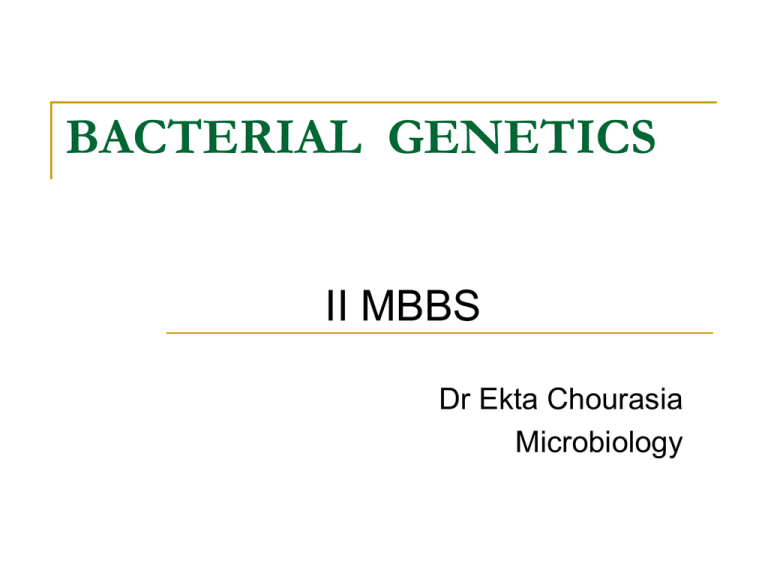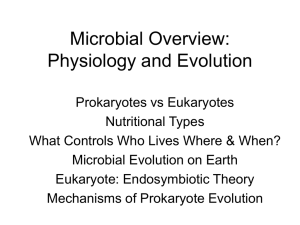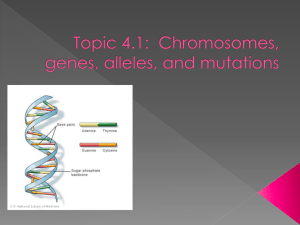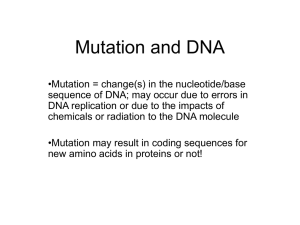
BACTERIAL GENETICS
II MBBS
Dr Ekta Chourasia
Microbiology
Key Words
Genetics
Bacterial genetics
Mutation & its types
Point mutation
Frameshift mutation
Lethal mutation
Suppressor mutation
Missense & nonsense
mutation
Bacteriophage
Lysogenic cycle
Mechanisms of gene
transfer
Transformation
Transduction
Lysogenic conversion
Conjugation
Transposition (Jumping
Genes)
Bacterial Genetics
Genetics is the study of heredity and variation.
The unit of heredity is gene, which is a segment
of DNA specifying for a particular polypeptide.
Introns - non coding sequences on a gene.
Exons - coding sequences on a gene translated into
gene products.
Bacterial genetics is used as a model to understand
DNA replication, genetic characters, their changes &
transfer to next generations.
Nucleic Acids
DNA ( deoxy ribonucleic acid ) : stores
information for protein synthesis.
RNA ( ribonucleic acid ) : transcription &
translation of information for protein synthesis.
Central Dogma : DNA
RNA
Protein
Structure Of DNA
Proposed by Watson & Crick.
Double helix model.
Composed of 2 chains of polypeptides, each
chain has a backbone of deoxyribose sugar and
phosphate residues arranged alternately.
4 nitrogenous bases: Adenine (A) Purine
Guanine (G)
Thymine(T)
Pyrimidine
Cytosine (C)
Double helical structure of
DNA by Watson & Crick
Structure Of RNA
Structurally similar to DNA, except for 2
major differences:
ribose sugar
uracil in place of thymine.
3 types of RNA
m RNA (messenger RNA)
t RNA ( transfer RNA )
r RNA ( ribosomal RNA )
Genetic Information In Bacteria
Chromosome
Carries properties like virulence,
pathogenicity & resistance
Plasmid
Extrachromosomal genetic
material in the cytoplasm
Replicate independently
Bacteriophage
Virus infecting bacteria
PLASMIDS
Circular DNA molecules
Important vectors in genetic engineering
EPISOME
Plasmid DNA integrated with chromosomal DNA.
Types of plasmids
R plasmid (drug resistance): RTF + r determinant
F plasmid (maleness )
Genotypic & Phenotypic Variations
Genotype – genetic constitution of a cell that is
transmitted to its progeny
Phenotype – physical expression of the genotype
in a given environment
Variations
Phenotypic variations –
1.
influenced by the environment
temporary & not heritable
Genotypic variations –
2.
Not influenced by the environment
Stable & heritable
Mechanisms Of Genetic Variations
Mutation
Transfer or exchange of genetic material
1.
2.
3.
4.
5.
Transformation
Transduction
Conjugation
Lysogenic conversion
Transposition
Mutation
Random, undirected heritable variation
Caused by a change in the nucleotide base
sequence of the DNA
Types of mutation:
1.
2.
3.
4.
Point mutation
Frame shift mutation
Lethal mutation
Suppressor mutation
Mutagens - Agents which can induce mutation e.g.
UV rays, 5 bromouracil, alkylating agents, etc.
1. Point Mutation
Cause - due to addition, deletion or
substitution of one or more bases.
Types
Transition : a purine base is replaced by a
purine base or a pyrimidine base is replaced
by another pyrimidine base.
Most common type.
Transversion : substitution of a purine base by
a pyrimidine base & vice versa
1. Point Mutation
Results of mutation
Missense mutation – triplet code is
altered so that a different amino
acid is present at a particular
position in the protein.
Nonsense mutation – converts a
codon that specifies an amino acid
into a termination codon.
2. Frame Shift Mutation
Cause - Deletion or
insertion of a base changes all of the
codons downstream
from the change
3. Lethal Mutation
Mutation which resulting involve vital functions
in the death of the organism – nonviable
mutation.
A conditional lethal mutant may be able to live under
certain conditions – permissive conditions.
Commonest type of conditional mutant is the
temperature sensitive (ts) mutant which is able to live
at the permissive temperature of 35C but not at the
restrictive temp (39C).
4. Suppressor Mutation
Reversal of a mutant phenotype by another mutation at a
position on the DNA, distinct from that of the original
mutation.
Transformation (Griffith, 1928)
Transfer of genetic information by free DNA. i.e. by
direct uptake of donor DNA by the recipient DNA.
Live noncapsulated (R) pneumococci + heat killed
capsulated (S) pneumococci
Injected into mice
Death of mice
Live capsulated pneumococcus isolated from the
blood of mice.
Transduction
Transfer of a portion of the DNA from one bacterium to
another by a bacteriophage.
Packaging error within the infected bacteria during the
assembly of progeny phages – presence of a segment of
host DNA along with the phage nucleic acid in the core of
phage
Infection of another bacterium
Transfer of host bacterial DNA to the new bacterium
Acquisition of new characteristics coded by the donor DNA.
Transduction
Types of Transduction –
1. Generalized - When it involves any segment of the DNA
2. Restricted - When a specific bacteriophage transduces only a
particular genetic trait.
Episomes & plasmids can also be transduced.
Most widely used mechanism of gene transfer among
prokaryotes
Any group of bacteria for which bacteriophages exist,
can be subjected to transduction.
Lysogenic Conversion
Phage DNA itself is the new genetic element.
Bacteriophages – 2 Types of life cycle
Lytic or virulent cycle – progeny viruses build
up inside host bacterium, which rupture to
release them.
Temperate or nonlytic or lysogenic cycle –
host bacterium is unharmed.
This process is called Lysogeny & the bacteria
harbouring these prophages are called Lysogenic
bacteria. Prophage behaves as an additional
segment of bacterial chromosome, coding for
new characteristics. This process by which
prophage confers genetic information to a
bacterium is called Lysogenic conversion .
By lysogenic conversion diphtheria bacilli acquire
toxigenicity & therefore virulence. Elimination of
phage renders a toxigenic strain non- toxigenic.
Conjugation
First described by Lederburg & Tatum in 1946 in a strain of E.coli
called K12.
A donor or male bacterium passes DNA directly to a recipient or
female bacterium by a conjugation tube (sex pili). The female
bacterium attains donor status & in turn can conjugate with other
female cells.
Maleness is determined by the presence of a plasmid which
codes for sex pili.
The plasmid is called the sex factor or fertility factor (F factor)
R (resistance) factor can also be transferred by conjugation
Process of Conjugation
Transposon (Jumping Genes, Barbara McClintock)
DNA segment that can move
between chromosome & plasmids
Plasmid
Chromosome
Insertion of transposon into a functional
gene would destroy the function of the
gene (internal mutagenic agents)
Transposon
Transposons are not self replicative, they depend on chromosomal or
plasmid DNA for replication










